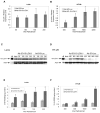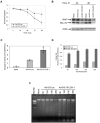Therapeutic molecular targeting of 15-lipoxygenase-1 in colon cancer
- PMID: 18388920
- PMCID: PMC2377397
- DOI: 10.1038/mt.2008.44
Therapeutic molecular targeting of 15-lipoxygenase-1 in colon cancer
Abstract
Molecular targeting for apoptosis induction is being developed for better treatment of cancer. Downregulation of 15-lipoxygenase-1 (15-LOX-1) is linked to colorectal tumorigenesis. Re-expression of 15-LOX-1 in cancer cells by pharmaceutical agents induces apoptosis. Antitumorigenic agents can also induce apoptosis via other molecular targets. Whether restoring 15-LOX-1 expression in cancer cells is therapeutically sufficient to inhibit colonic tumorigenesis remains unknown. We tested this question using an adenoviral delivery system to express 15-LOX-1 in in vitro and in vivo models of colon cancer. We found that (i) the adenoviral vector 5/3 fiber modification enhanced 15-LOX-1 gene transduction in various colorectal cancer cell lines, (ii) the adenoviral vector delivery restored 15-LOX-1 expression and enzymatic activity to therapeutic levels in colon cancer cell lines, and (iii) 15-LOX-1 expression downregulated the expression of the antiapoptotic proteins X-linked inhibitor of apoptosis protein (XIAP) and BcL-XL, activated caspase-3, triggered apoptosis, and inhibited cancer cell survival in vitro and the growth of colon cancer xenografts in vivo. Thus, selective molecular targeting of 15-LOX-1 expression is sufficient to re-establish apoptosis in colon cancer cells and inhibit tumorigenesis. These data provide the rationale for further development of therapeutic strategies to target 15-LOX-1 molecularly for treating colonic tumorigenesis.
Figures




Similar articles
-
Therapeutic Molecular Targetingof 15-Lipoxygenase-1 in Colon Cancer.Mol Ther. 2008 May;16(5):886-892. doi: 10.1038/mt.2008.44. Epub 2016 Dec 8. Mol Ther. 2008. PMID: 28178489
-
15-Lipoxygenase-1 as a tumor suppressor gene in colon cancer: is the verdict in?Cancer Metastasis Rev. 2011 Dec;30(3-4):481-91. doi: 10.1007/s10555-011-9321-0. Cancer Metastasis Rev. 2011. PMID: 22037943 Free PMC article. Review.
-
The critical role of 15-lipoxygenase-1 in colorectal epithelial cell terminal differentiation and tumorigenesis.Cancer Res. 2005 Dec 15;65(24):11486-92. doi: 10.1158/0008-5472.CAN-05-2180. Cancer Res. 2005. PMID: 16357157 Free PMC article.
-
The 15-lipoxygenase-1 product 13-S-hydroxyoctadecadienoic acid down-regulates PPAR-delta to induce apoptosis in colorectal cancer cells.Proc Natl Acad Sci U S A. 2003 Aug 19;100(17):9968-73. doi: 10.1073/pnas.1631086100. Epub 2003 Aug 8. Proc Natl Acad Sci U S A. 2003. PMID: 12909723 Free PMC article.
-
Eicosanoid profiling in colon cancer: emergence of a pattern.Prostaglandins Other Lipid Mediat. 2013 Jul-Aug;104-105:139-43. doi: 10.1016/j.prostaglandins.2012.08.004. Epub 2012 Sep 1. Prostaglandins Other Lipid Mediat. 2013. PMID: 22960430 Free PMC article. Review.
Cited by
-
The suppression of cervical cancer ferroptosis by macrophages: The attenuation of ALOX15 in cancer cells by macrophages-derived exosomes.Acta Pharm Sin B. 2023 Jun;13(6):2645-2662. doi: 10.1016/j.apsb.2023.03.025. Epub 2023 Mar 31. Acta Pharm Sin B. 2023. PMID: 37425043 Free PMC article.
-
Effect of cyclooxygenase genotype and dietary fish oil on colonic eicosanoids in mice.J Nutr Biochem. 2012 Aug;23(8):966-76. doi: 10.1016/j.jnutbio.2011.05.003. Epub 2011 Sep 19. J Nutr Biochem. 2012. PMID: 21937210 Free PMC article.
-
Interactions between ferroptosis and tumour development mechanisms: Implications for gynaecological cancer therapy (Review).Oncol Rep. 2025 Feb;53(2):18. doi: 10.3892/or.2024.8851. Epub 2024 Dec 5. Oncol Rep. 2025. PMID: 39635847 Free PMC article. Review.
-
Suppression of Membranous LRP5 Recycling, Wnt/β-Catenin Signaling, and Colon Carcinogenesis by 15-LOX-1 Peroxidation of Linoleic Acid in PI3P.Cell Rep. 2020 Aug 18;32(7):108049. doi: 10.1016/j.celrep.2020.108049. Cell Rep. 2020. PMID: 32814052 Free PMC article.
-
Resolution, the grail for healthy ocular inflammation.Exp Eye Res. 2010 Oct;91(4):478-85. doi: 10.1016/j.exer.2010.07.004. Epub 2010 Jul 14. Exp Eye Res. 2010. PMID: 20637194 Free PMC article. Review.
References
-
- Hawk ET, Levin B. Colorectal cancer prevention. J Clin Oncol. 2005;23:378–391. - PubMed
-
- Gibbs JB. Mechanism-based target identification and drug discovery in cancer research. Science. 2000;287:1969–1973. - PubMed
-
- Kuhn H, Walther M, Kuban RJ. Mammalian arachidonate 15-lipoxygenases structure, function, and biological implications. Prostaglandins Other Lipid Mediat. 2002;68–69:263–290. - PubMed
-
- Shureiqi I, Wojno KJ, Poore JA, Reddy RG, Moussalli MJ, Spindler SA, et al. Decreased 13-S-hydroxyoctadecadienoic acid levels and 15-lipoxygenase-1 expression in human colon cancers. Carcinogenesis. 1999;20:1985–1995. - PubMed
Publication types
MeSH terms
Substances
Grants and funding
LinkOut - more resources
Full Text Sources
Medical
Research Materials

